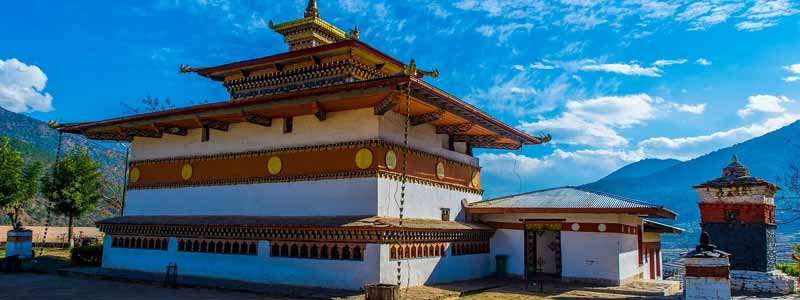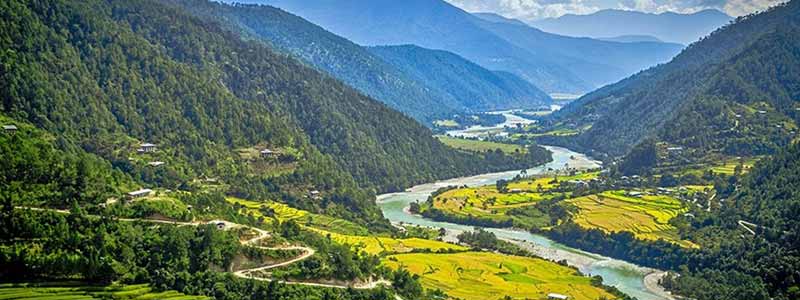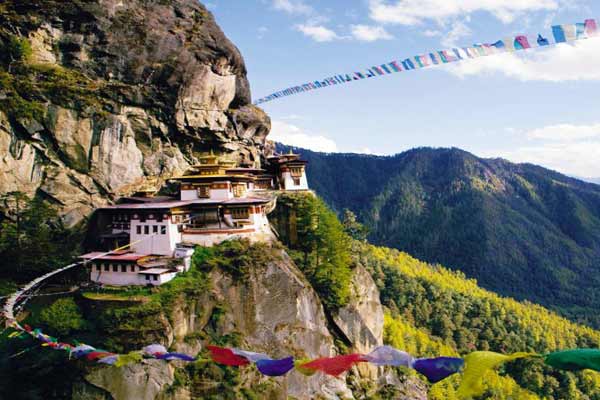Top 10 Things to do Bhutan is the last kingdom of the Himalayas, surrounded by impressive snow peak mountains and shady forests that produce picturesque landscapes. But that’s not all; the interesting and greatest thing about Bhutan is that it’s the only country that’s 72 per cent covered in trees, making it the only carbon-neutral country in the world. Besides that, Bhutan is a place where traditional Buddhists live Culture meets magnificent fortifications such as dzongs and monasteries, it’s definitely a beautiful and mysterious place to be. Its distinctive monastic architecture and the graffiti on the walls bearing penis paintings as a symbol of keeping away the evil make Bhutan a destination sui generis. Renowned as the last Shangri La, the country of its kind It is probably the best place to visit for a family vacation, honeymoon tours and even an adventure vacation. And to be part of this fascinating city, through this guided list of the top tourist attractions you need to see and do, you can have your own share of Bhutan experience.

Chime Lhakhang
Known as the Temple of Fertility, the holy Chimi Lhakhang is a revered place of magic and miracles. Blessed by the eccentric maverick yogi and saint Drukpa Kunley, regarded as the ‘Divine Madman’ and father of fertility, he had very unorthodox teaching methods and it is said that this Buddhist monastery is a place of fertility and blessings. Incapable of falling pregnant and childless couples Devoted pilgrimage here in the hope that the Buddhist monk and his ‘magic thunderbolt of wisdom’ would grace them with a wang or blessing. Woman entering the temple who wishes to conceive will be forced to bring a wooden phallus three times across the temple.

Paro Valley
The elegant, traditional-style houses which dot the valley and surrounding hills accentuate the natural beauty. One of the distinctive features of Paro town is that it is located at the bottom of a flat valley, following a grid-like pattern. The central plaza is decorated with a huge prayer wheel and a small amphitheatre, where activities take place all year long.
The region boasts more than 155 temples and monasteries, some dating back to the 14th century. The city is also host to the country’s first and only international airport. Its close proximity to the region’s historical and religious sites has led to the construction of an array of luxury, high-end tourist resorts making Paro one of the tourists’ key destinations.
The area includes the Taktsang Monastery, the Tiger’s Nest, one of the most famous landmarks in Bhutan. This magnificent temple was built on a pure cliff face above oak and rhododendron forests. The Ta Dzong National Museum is also situated in Paro. An ancient watchtower showing hundreds of ancient objects and artworks from Bhutan, including traditional costumes, armour, weapons, and handcrafted implements for daily life. The National Museum collection retains a snap-shot of the country’s rich cultural traditions. Another place worth a visit is Drugyel Dzong or The Triumphant Bhutanese Fortress in Paro. It was built in 1646 by Zhabdrung Ngawang Namgyal to commemorate his victory over Tibetan marauding armies. In 1951 the fortress was destroyed by fire but the ruins remain an impressive and intimidating view.
Taktsang Monastery
Taktsang translates into The Nest of the Tiger. The monastery is precariously perched on a hill, 900 metres above the Paro valley. It has a history which is equally interesting. According to the legend, Guru Rinpoche travelled 3 months and 3 days in a cave to subdue an evil force and restore the land to the current site of the monastery riding on top of a tigress. Afterwards the monastery was founded at the site in 1692. Guru Rinpoche is a Buddhist saint who initiated the Buddhism in Bhutan according to tradition.
Tourists will arrive at the base of the monastery about a 20-minute drive from the area, and begin an uphill climb on foot. The Tiger’s Nest is Bhutan’s most visited tourist attraction, and is one of the most visited due to its history sacred religious site in the country. The wide dirt trail brings hikers through the forest of pines. As the hike reaches its top, visitors can take in the stunning panoramic view of the valley below and a close-up view of the above apparently floating monastery into the sky.
(Taktshang or Tiger ‘s Nest Monastery is truly one of the most beautiful sites and venerated pilgrimage sites in the Himalayan Buddhist world. At 2.950 metres above sea level the monastery clings to the side of a precipitous rock face. It takes about 2 hours for the average hiker to get to the monastery. Getting there does take some work, but every bead of sweat is truly worth it.
Punakha Festival
In Bhutan, mask dances are very common and there are many occasions that give you the opportunity to enjoy these. One such occasion is the Punakha Tshechu festival in Bhutan, an event that takes place within the Punakha Dzong once a year. In addition to being the administrative centre of the Punakha district, it is the second-oldest and second-largest dzong in Bhutan. In any travel guide to Bhutan it always finds a mention as a must-visit spot, both for its historical and cultural significance.
The word Tsechu means “tenth,” and on the 10th day of the Bhutanese calendar also this festival is celebrated. Also this date is associated with a significant religious celebration, Guru Rinpoche ‘s birthday. Also known as Padmasambhava, he was a Buddhist philosopher and master living in the 8th century. In fact his followers hold him in such high regard that he is revered by followers of Tibetan Buddhism in Tibet, Nepal and Bhutan as “the second Buddha.” In all twenty districts of Bhutan, apart from Punakha, Punakha Tshechu, one of the most popular festivals in Bhutan, is held.
Dochu La Pass
Dochula Pass is a mountain pass of Bhutan, located along the Thimphu to Punakha route. The Dochula Pass, perched at an altitude of 3100mt, is Thimphu ‘s highest motorable point. Overlooking the snow-capped mountains, Aberula Pass is marked by 108 chortens in memorial.
Festooned with colourful prayer flags, Aberula Pass in Thimphu is considered a historical and religious site. With the breathtaking view over the valley surrounding the Thimphu Valley of shimmering Mt Gangkhar Puensum, Dochula Pass has become one of Bhutan’s must-visit places and a favourite sightseeing spot in Thimphu.
Gangtey
Gangtey Valley is one of Bhutan ‘s loveliest spots. The surprise of finding such a large , flat valley without any trees after the hard climb through dense forests is compounded by an impression of vast space, and extremely rare experience in Bhutan where most of the valley’s are tightly enclosed.
A few kilometres beyond Gangtey Monastery, The village of Phobjikha lies at the valley floor. This place is the winter home of black necked cranes migrating from the arid plains of the north to travel in milder and lower climatic winters. Phobjikha, at an altitude of 2900 m above sea level, falls under the Wangduephodrang district and lies on the Black Mountain National Park periphery. The valley boasts two small, meandering rivers, Nakay Chhu (Chhu Naap-black water) and Gay Chhu (Chhu Karp-white water).
The two rivers in reality represent a snake and a boar according to a local legend. If the two animals raced each other with an agreement that if the snake (Nakay Chhu) won, the Phobjikha valley could grow rice, but if the boar won, rice could never be grown in the region. The snake lost because during its journey, it had to meander all the way. Can’t cultivate rice in the valley even today.
Tashicho Dzong
Tashichoedzong, meaning the “auspicious doctrine” fortress, has historically been the seat of the Dharma Raja and the country’s summer capital. In 1641 Zhabdrung built the Tashicho Dzong instead of the Dho Ngon Dzong established by Lama Gyalwa Lhanangpa. When Dechen Phodrang was destroyed by fire in 1771, it all moved to the lower Dzong, which was then enlarged, and again to the 13th Druk Desi (1744-1763), And it expanded further in 1866. It was destroyed during an 1897 earthquake and repaired in 1902. After he moved the capital to Thimphu in 1952, King Jigme Dorji Wangchuck had it fully renovated and extended over five years. It currently houses the King’s throne room and offices, the Secretariat, and the home affairs and finance ministries. The Tashichoe Dzong’s main structure is two-story with four three-story towers at each corner, surmounted by triple-tiered golden roofs. A broad central tower named utse is located in the centre of the building.
This fortress acts as the King’s office, ministers, and numerous governmental agencies. It is also the headquarters for Bhutan ‘s central monastic body. The spiritual leader of Bhutan, Je-Khenpo, and the monks of Thimphu and Punakha both live here during the summer.
Kurje Lhakhang
In the 8th century the king of Bumthang area became seriously ill after falling out with the local guardian deity. Desperate to recover from the curse, Guru Rinpoche has been invited to Bumthang to help the King regain his health. Guru Rinpoche meditated in a cave to subdue the local god, and forced the King’s health to be restored. There remained imprints of Guru ‘s body in that cave, and thus the name Kurje which means the imprint of the body.
First Governor of Trongsa built a temple surrounding the cave in 1652. Today the Kurje complex comprises three main Lhakhangs. Cypress tree near the entrance is also believed to be an offshoot of Guru Rinpoche’s walking stick.
(Kurjey Lhakhang, translated as ‘Holy Body Temple,’ is one of the most sacred places and an important place of pilgrimage for all devout Buddhists. It was built around a rock on which Guru Rinpoche left an imprint of his body while mediating there in the 8th century, where he had come to save the life of Sendha Gyelpo, the Bumthang king. At Kurjey, the Guru defeated and conquered the local deity Shelging Karpo, who had controlled the king’s life force, in the form of a Garuda. Having saved the king’s life, Shelging Karpo was further converted to the faith and made her faithful protector, bound by oath to protect and propitiate the Dharma. Today Shelging Karpo at Kurjey Lhakhang is worshipped as the Local Deity and is frequently propitiated by both tourists and locals.
Trongsa Dzong
The Warriors’ Vanguard-Trongsa Dzongkhag is located near Bhutan ‘s centre and has been considered crucial in governing the kingdom in earlier years because of its strategic location.
This town is built on a steep ridge and provides stunning views of the surrounding deep valleys. From their balconies the numerous hotels, guesthouses and restaurants all deliver breathtaking views. Trongsa Dzong is easily visible from anywhere in town and is always an impressive sight as it is perched atop a steep ridge on its southern side, falling into the clouds.
Founded in 1644, the Trongsa Dzong used to be the Wangchuck dynasty’s seat of power until they became Bhutan’s rulers in 1907. The King of Bhutan usually becomes first the Trongsa Penlop (governor) before being appointed the Crown Prince and finally the King. Founded on a mountain spur high above the Mangde Chhu Gorges, dzong has for centuries regulated east-west commerce. Also Trongsa boasts an impressive museum. The Trongsa Watchtower has been turned into a museum dedicated to the Wangchuck dynasty, and is a good place to learn about the kingdom ‘s history.
During December or January, a five-day festival known as the Trongsa tsechu is held at the northern courtyard.Every monastery in Bhutan observes this festival, which celebrates Guru Rimpoche ‘s arrival to Bhutan in the 8th century, a symbol of Buddhism ‘s triumph over evil. According to the Bhutanese calendar it is held in spring and autumn seasons.
Punakha Dzong
The Punakha Dzong (the palace of great happiness or bliss), is the Punakha District administrative centre in Punakha, Bhutan. Ngawang Namgyal founded the dzong, in 1637–38. It is Bhutan’s second-oldest and second-largest dzong, and one of its most majestic buildings. The dzong houses the holy artefacts of the Kagyu School of Tibetan Buddhism Southern Drukpa Lineage, including the Rangjung Kasarpani and the sacred remains of Ngawang Namgyal and the tertoen Pema Lingpa.
The Dzong is located in the Punakha – Wangdue Valley, at the confluence of the rivers Pho Chhu (father) and Mo Chhu (mother). The source of the Mo chu river is in Bhutan, and Tibet, in the northern hills of Ligshi and Laya. The Pho Chu River is fed by Punakha valley glaciers in the Lunana region. The main river is known as Puna Tsang chu after the confluence of those two rivers.
In view of the region’s safe climate Punakha is Bhutan ‘s winter capital. The head of Bhutan’s clergy spend the winter in this dzong with his entourage of monks. Jacaranda trees flourish throughout the dzong, blooming in spring with mauve flowers. Punakha is also the hub of the longest suspension bridge in Bhutan (Punakha Suspension Bridge), which is approximately 7.5 km (4.5 miles ) away. by car to Chimi Lhakhang, the Divine Madman’s fertility temple.
